
* In the 1960s, a consortium of Japanese companies developed Japan's first modern airliner, the twin-turboprop NAMC "YS-11", which proved modestly successful in civil and military roles. It was followed in the 1970s by Japan's first modern cargolift aircraft, the Kawasaki "C-1", which was built in small quantities. The C-1 is now to be replaced by the much-improved Kawasaki "C-2" cargolifter. This document provides a history and description of the YS-11, C-1, and C-2 -- as well as the "P-1" maritime patrol aircraft, being developed by Kawasaki in parallel with the C-2. A list of illustration credits is provided at the end.
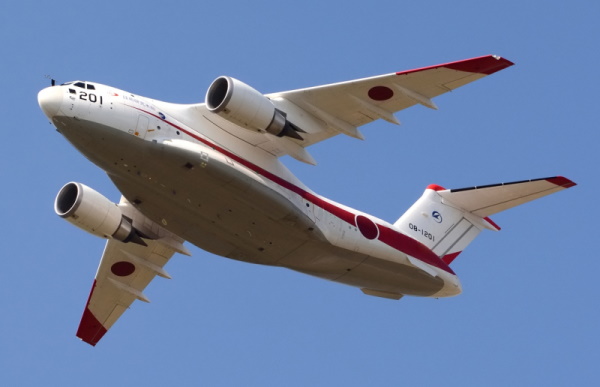
* In the latter half of the 1950s, the Japanese Ministry of International Trade & Industry (MITI) suggested that Japan's aircraft industry collaborate on a new short-haul airliner to replace Douglas DC-3s that were then hauling passengers on domestic routes. In 1959, following a government investigation, Mitsubishi Heavy Industries, Kawasaki Heavy Industries, Fuji Heavy Industries, Shin Meiwa, Showa Aircraft Industry Company, and Japan Aircraft Industry Company formed a subsidized joint venture to build the machine -- the joint operation being named the "Nihon Aeroplane Manufacturing Company (NAMC)".
The initial prototype of the NAMC "YS-11" made its maiden flight on 30 August 1962, with a second prototype flying on 28 December 1962. Two static-test prototypes were built as well. Japanese certification was in 1964, the same year the first production machine was rolled out, with American certification following in 1965, the same year of first customer deliveries of the baseline "YS-11-100".
The airliner NAMC came up with was, by all appearances, a scaled-up Hawker-Siddeley HS.748. Obviously, since the HS.748 wasn't in service at the time, it wasn't a copy in any real sense -- but in the postwar period, the Japanese were inclined to use aircraft of other nations for inspiration. Like the HS.748, the YS-11 was a low-wing airliner of all-metal construction, constructed mostly of aircraft aluminum alloy, with tricycle landing gear and twin turboprops -- as with the HS 746, Rolls-Royce Darts, but more powerful Dart RDa.10/1 engines with 2,275 kW (3,050 EHP) each, featuring water-methanol injection for take-off power and driving four-bladed reversible Rotol propellers.
An AiResearch auxiliary power unit (APU) for ground power and engine starting was optional. Fuel tanks were in the wings, inboard and outboard of the engines, with a total fuel capacity of 7,270 liters (1,918 US gallons). The control surface arrangement was conventional: ailerons, Fowler flaps, rudder, elevators. Both wings and tail surfaces had pneumatic de-icing boots -- though the tail de-icing boots were not fitted in early production. All landing gear assemblies had twin wheels and retracted forward, the main gear tucking into the engine nacelles.
Aircrew for YS-11 included a cockpit crew of two, along with two flight attendants. Avionics were conventional for the time, including radios, intercom, radio navigation and landing aids, plus weather radar -- the radar type being specified as per customer request. There was seating for 60 passengers, in four-across rows; of course, the YS-11 was pressurized and climate-conditioned. There was a galley and toilet at the rear of the cabin, with a baggage hold behind the cabin; there was also a cargo hold under the floor, forward of the wings.
Total production of the baseline YS-11 was 48 aircraft. Only a handful were sold to foreign users, the YS-11 having been designed for domestic requirements; it was underpowered, particularly for operators that had to fly under "hot & high" conditions. However, in 1966, the NAMC group announced a new series of aircraft using Dart Mark 542 turboprops, with much the same power ratings, but water-methanol injection to provide boosted take-off power.
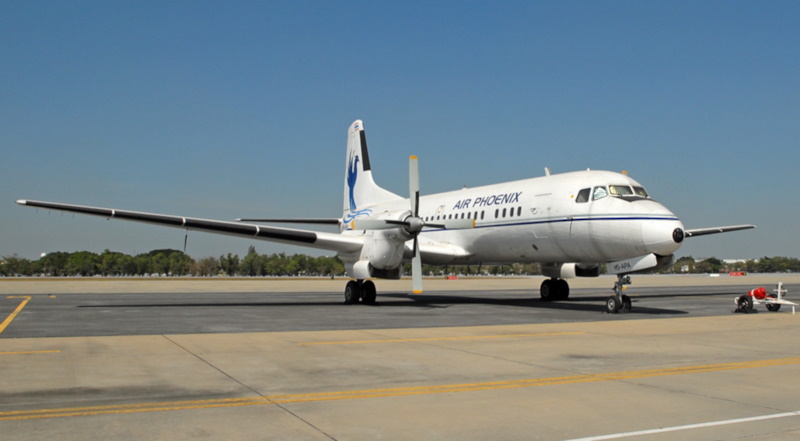
The resulting "YS-11A-200" airliner performed its first flight on 27 November 1967, with certification and deliveries in 1968. It was much more popular on the export market, obtaining customers in the USA -- Piedmont Airlines eventually obtained 22. The "YS-11A-300CP" was much the same, but was a "combi" machine for combined passenger-freight haulage, with a 2.48 x 1.8 meter (8 feet 2 inch x 6 foot) cargo door in the front left fuselage. An airliner version with further increased maximum take-off (MTO) weight, the "YS-11A-500", was introduced, along with a "YS-11A-600" combi variant.
___________________________________________________________________
NAMC YS-11A-200:
___________________________________________________________________
wingspan:
32 meters (105 feet)
wing area:
94.83 sq_meters (1,020 sq_feet)
length:
26.3 meters (86 feet 3 inches)
height:
8.99 meters (29 feet 6 inches)
empty weight:
14,600 kilograms (32,185 pounds)
MTO weight:
23,500 kilograms (51,800 pounds)
cruise speed:
455 KPH (280 MPH / 245 KT)
service ceiling:
6,980 meters (22,900 feet)
range, with payload:
2,200 kilometers (1,365 MI / 1,190 NMI)
___________________________________________________________________
The YS-11 was obtained by the Japan Air Self-Defense Force (JASDF) and Maritime Self-Defense Force (JMSDF). YS-11s obtained by the JASDF included:
The JMDSF flew a handful of "YS-11T" transports. A number of late-delivery SDF machines were fitted with General Electric T64-IHI-10J turboprops, built under license by Ishikawajima-Harima Heavy Industries. These machines were designated "YS-11E" AKA "Super YS".
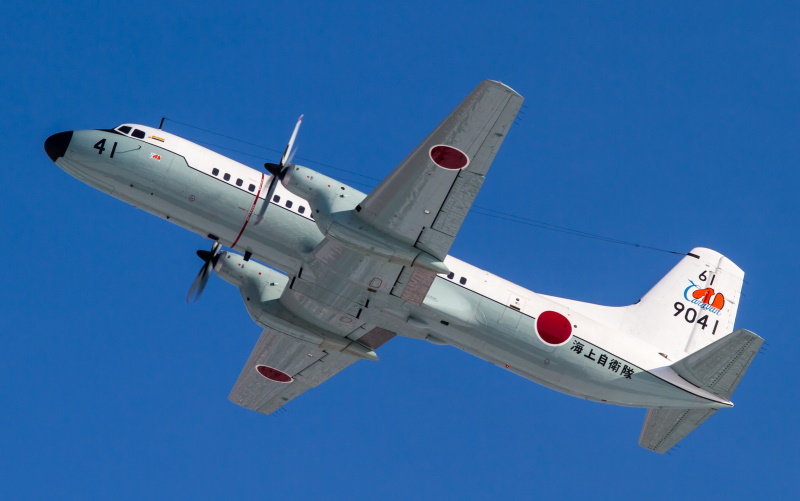
182 YS-11s of all variants were built in all, the last being delivered to the JMSDF in 1973. The YS-11 was finally phased out of Japanese commercial service in 2006, after the government mandated that airlines be fitted with a Traffic Collision Avoidance System (TCAS). Refitting TCAS to such machines as were still flying was judged more than it would be worth, so they were retired. The JMSDF finally retired their YS-11 fleet in 2021.
BACK_TO_TOP* In the late 1960s, the JASDF began to search around for a replacement for the service's existing transport aircraft, such as the C-46 Commando. A design for a twinjet cargolift aircraft was submitted by the NAMC group, leading to award of a contract to a reshuffled industrial group led by Kawasaki for prototype development of the "C-1", as it was designated, in 1968.
The first of two "XC-1" flight prototypes performed its initial flight on 12 November 1970; a static-test airframe was built as well. The Japan Defense Agency (JDA) completed trials in 1973. Two pre-production aircraft were built, along with 27 production machines, last delivery to the JASDF being in 1981.
The C-1 was a tidy aircraft, made mostly of aircraft aluminum, of conventional cargolifter configuration: high-mounted wing with twin turbofans, rear fuselage with clamshell doors, swept tee tail, and tricycle landing gear with the main gear in sponsons to leave the cargo bay unobstructed. All flight surfaces were swept, the wing having a sweepback of 20 degrees at quarter-chord, the tailplane a sweepback of 20 degrees, and the tailfin a sweepback of 30 degrees, with a modest forward fillet. Each wing had two quadruple slotted flaps and an aileron in the rear, with three flight and one ground spoilers in front of the flaps, plus full-span leading-edge slats in four segments. Wing de-icing was by engine bleed air. The tail had conventional elevator and rudder controls, with electrical de-icing.
The powerplants were JT8D-M-9 turbofans, a Pratt & Whitney design built under license by Mitsubishi, providing 64.5 kN (6,575 kgp / 14,500 lbf) thrust each and fitted with thrust reversers. There were four integral fuel tanks in the wings. The nose gear had twin wheels and retracted forward, while each main gear assembly had four wheels in a 2x2 arrangement and retracted up. An APU was fitted in the right sponson for engine starting and ground power.
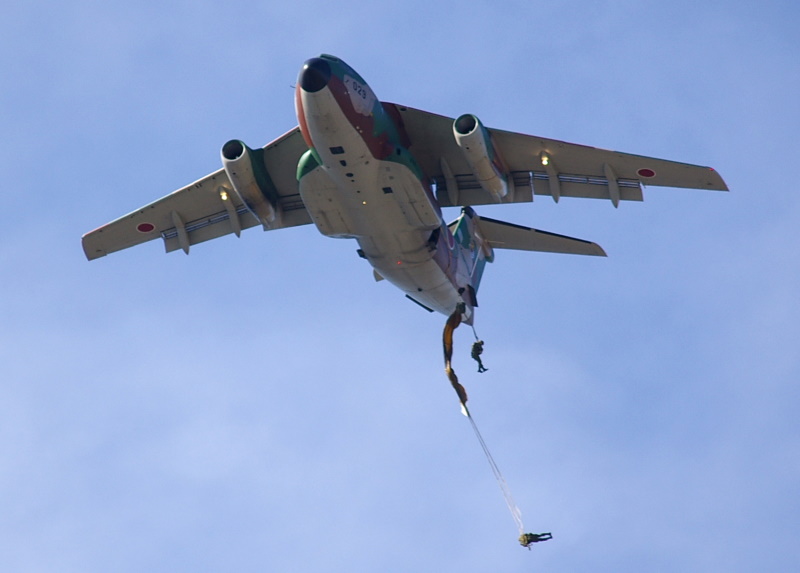
There was a flight crew of five; 60 troops could be carried, or 45 paratroops, or 36 litters with attendants, or up to 11,900 kilograms (26,265 pounds) of cargo. Avionics were standard for the era, including radios, navigation and landing aids, plus "identification friend or foe" transponder. The flight deck and main cabin were pressurized and climate-conditioned. There was a downward-opening crew door with a built-in "airstair" on the left front fuselage, and inward-opening paratroop doors on each side of the rear fuselage. The tail doors could be opened in flight for airdrops.
___________________________________________________________________
KAWASAKI C-1:
___________________________________________________________________
wingspan:
30.6 meters (100 feet 5 inches)
wing area:
120.5 sq_meters (1,297 sq_feet)
length:
29 meters (95 feet 2 inches)
height:
9.99 meters (32 feet 9 inches)
empty weight:
24,300 kilograms (53,570 pounds)
MTO weight:
45,000 kilograms (99,205 pounds)
cruise speed:
705 KPH (440 MPH / 360 KT)
service ceiling:
11,580 meters (38,000 feet)
range, with payload:
1,300 kilometers (805 MI / 700 NMI)
___________________________________________________________________
The C-1 did not prove entirely satisfactory in practice. While the Japanese are noted for high-quality consumer and industrial products, Japanese defense programs have an inclination towards producing mediocre products at exorbitant prices. This is partly due to the fact that the Japanese constitution restricts weapons exports, meaning production lots of weapon systems are likely to be small, and also because the Japanese government has an inclination to use defense programs as a means of spreading money around to Japanese industry. One particular issue was that the C-1 was simply too small, both in terms of load capacity and volume. There was thought of coming up with a stretched derivative, but the decision was made instead to obtain 16 Lockheed C-130 Hercules transports instead.
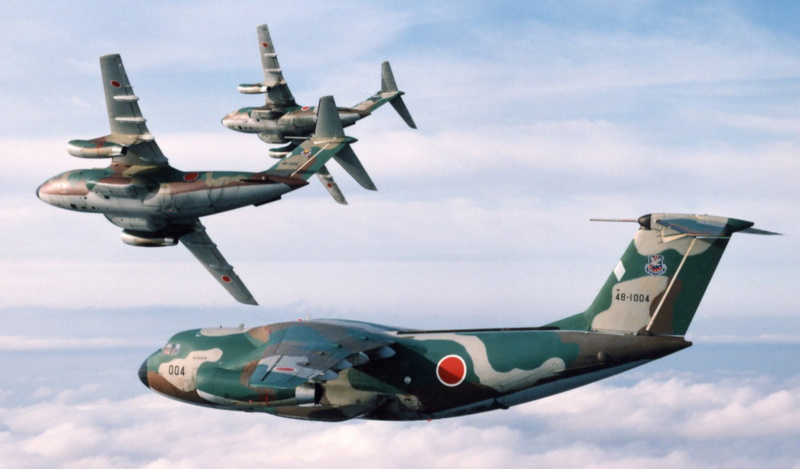
Three C-1s ended up as special-use aircraft:
The C-1 is being replaced by the C-2, described below.
BACK_TO_TOP* By the end of the century, the JASDF was in need of a replacement for their C-1 and C-130 cargolifters. After consideration of foreign-built alternatives, the decision was made to acquire a new Japanese-built aircraft for the requirement, with the JDA awarding a contract to Kawasaki Heavy Industries for what was then known as the "CX", the plan being to acquire 40 aircraft. A static-test airframe of the CX was delivered to the Japan Defense Agency in March 2006. Initial flight of the "XC-2" flight prototype was on 26 January 2010, with first delivery of the production "C-2" to the JASDF in the summer of 2016.
As introduced, the C-2 had a general configuration much like that of the C-1, with a high swept wing, twin turbofan propulsion, high swept tee tail, and rear clamshell doors with a loading ramp. The C-2 was, of course, generally modernized, with up-to-date systems and an aerodynamically refined wing. It was also a much more capable aircraft than the C-1, with over twice the empty weight, and a payload of 30 tonnes (33 tons). The C-2 was built mostly of aircraft aluminum, with composite tail flight surfaces.
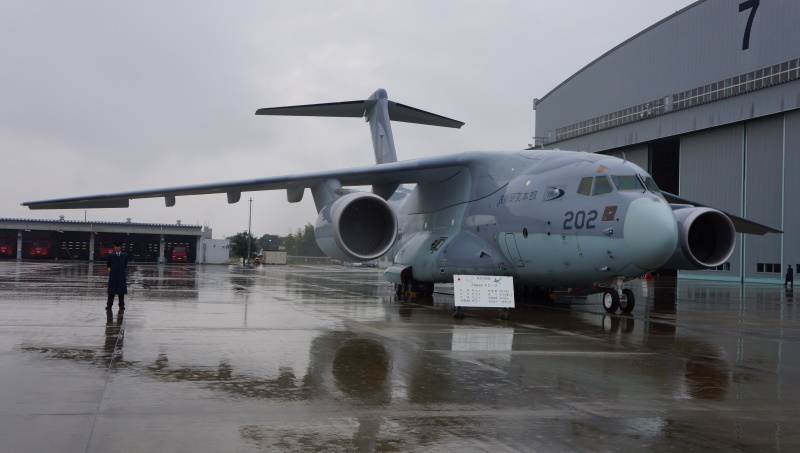
Each wing had two-segment flaps, four spoilers ahead of the flaps, and full-span leading-edge slats. The tailplane had elevators, and was all-moving for flight trim. The C-2 was powered by General Electric CF6-80C2 turbofans with 266 kN (27,090 kgp / 59,740 lbf) thrust each. The two-wheel nose gear retracted forward; each main gear had six wheels, in three rows of two, and retracted vertically into sponsons.
___________________________________________________________________
KAWASAKI C-2:
___________________________________________________________________
wingspan:
44.4 meters (145 feet 8 inches)
wing area:
170 sq_meters (1,830 sq_feet)
length:
43.9 meters (144 feet)
height:
14.2 meters (46 feet 7 inches)
empty weight:
60,800 kilograms (133,920 pounds)
MTO weight:
141,000 kilograms (310,000 pounds)
cruise speed:
890 KPH (550 MPH / 480 KT)
service ceiling:
12,190 meters (40,000 feet)
range, max payload:
5,600 kilometers (3,480 MI / 3,025 NMI)
___________________________________________________________________
The C-2's cargo bay had a height of 4 meters (13 feet), a width of 4 meters, and a length of 16 meters (52 feet), with a 5.5-meter (18-foot) loading ramp. The bay had a cargo handling system, including retractable floor rollers. The C-2 was flown by two aircrew, along with a loadmaster when required, and featured a glass cockpit, with a fly-by-light flight control system and fully integrated flight-management system.
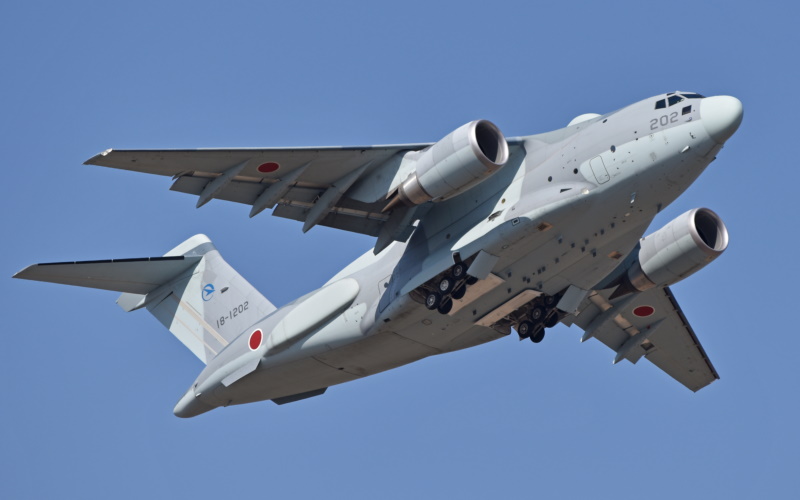
A signals intelligence (SIGINT) variant, the "RC-2", first flew in 2018, and was brought into service in 2020. As introduced, it featured an antenna dome on top of the forward fuselage, a canoe-style antenna fairing on top of the rear fuselage, antenna fairings scabbed onto both sides of the rear fuselage, an extended tailcone, and a "farm" of blade antennas under the forward fuselage. It is unclear how many RC-2s will be built; the first was modified from the second XC-2 prototype.
The Japanese government is planning to obtain a electronic warfare (EW) aircraft, presumably an "EC-2", carrying high-power jamming gear. No specifics have been announced, other than that four prototypes will be built, with introduction to service in 2032. There has been consideration of a civil cargolifter derivative of the C-2, though no commitment to it yet.
BACK_TO_TOP* In parallel with the C-2 development effort, Kawasaki Heavy Industries was given a contract to develop a replacement for the Lockheed P-3C Orion maritime patrol aircraft operated by the Japanese Maritime Self-Defense Force (JMSDF). The new aircraft, originally designated the "PX", was to leverage as much as possible off the C-2 program to reduce costs.
The first of two "XP-1" flight prototypes took to the air for the first time on 28 September 2007, the second following in June 2008; two static test prototypes were built as well. Initial service deliveries to the JMSDF were in 2013, with 65 to be obtained in all.
Although the P-1 shared subassemblies with the C-2, the two aircraft had no obvious resemblance to each other: the P-1 actually looked something like a scaled-down maritime patrol variant of the classic Boeing 707 jetliner, with a low swept wing, four engines, and conventional swept tail assembly. As with the C-2, the aircraft was built mostly of aviation aluminum alloys plus composite tail flight surfaces; the outer wings were the same as those of the C-2, as was the tailplane.
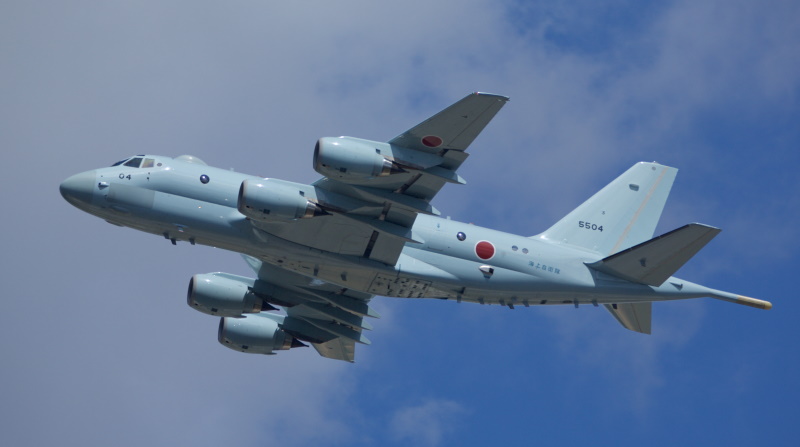
Each wing had five Fowler-type flaps in the rear, with an aileron outboard, plus full-span leading-edge slats. Tail control surfaces were conventional rudder and elevators, with an all-moving tailplane for flight trim. The P-1 was powered by four IHI XF7-10 turbofans, providing 59.8 kN (6,120 kgp / 13,450 lbf) thrust and featuring thrust reversers. A Honeywell 131-9J APU provided starting and ground power, while a ram-air turbine (RAT) provided emergency air power. The nose gear had twin wheels and retracted forward, while each main gear had four wheels in a 2x2 bogey configuration, mounted in the inner wing and retracting inward towards the fuselage.
___________________________________________________________________
KAWASAKI P-1:
___________________________________________________________________
wingspan:
35.4 meters (116 feet 2 inches)
wing area:
170 sq_meters (1,830 sq_feet)
length:
38 meters (124 feet 8 inches)
height:
12.1 meters (39 feet 8 inches)
MTO weight:
79,700 kilograms (175,705 pounds)
cruise speed:
835 KPH (520 MPH / 450 KT)
range:
7,965 kilometers (4,950 MI / 4,300 NMI)
___________________________________________________________________
Sensor systems included:
The P-1 also had an electronic support measures system to spot radio and radar emitters; it appears that countermeasures systems were not fitted, but could be easily added if need be. The P-1 had a weapons bay plus eight underwing pylons, four per wing -- two inboard of the inner engine, one between the engines, one outboard of the outer engine -- with offensive stores including mines, depth charges, homing torpedoes, and antiship missiles such as the US Harpoon or Japanese ASM-1C. Total external stores load was 7,250 kilograms (16,000 pounds).
The P-1 had a cockpit crew of two, along with seats for an optional flight engineer and an observer. It featured a glass cockpit inherited from the C-2, with a triple-redundant fly-by-light flight control system, and fully integrated flight-management system; it also had a datalink and satellite communications system. There were stations for a tactical coordinator, navigation-communications systems specialist, and four mission systems operators. There was a crew door on the left rear fuselage. The Japanese plan to obtain a SIGINT variant of the P-1, to replace their current fleet, based on the Lockheed Martin P-3. Details are unclear.
Japan having relaxed its self-prohibitions on weapons exports, Kawasaki has tested the waters for export sales of the P-1, sending it to the UK in 2015 as a potential solution for a British maritime patrol aircraft requirement. While a sale to the UK would be a departure for modern Japan, it would not be unprecedented, since Britain and Japan had a formal military alliance a century ago.
BACK_TO_TOP* As a footnote: In 2021, Korea Aerospace Industries (KAI) revealed a design for a twin-turbofan cargolift aircraft, the "MC-X", with a resemblance to the Kawasaki C-2. KAI suggested a range of uses for the machine, along with cargolift / paradropping:
No hardware has been built to date, but it doesn't appear the project has been abandoned, either.
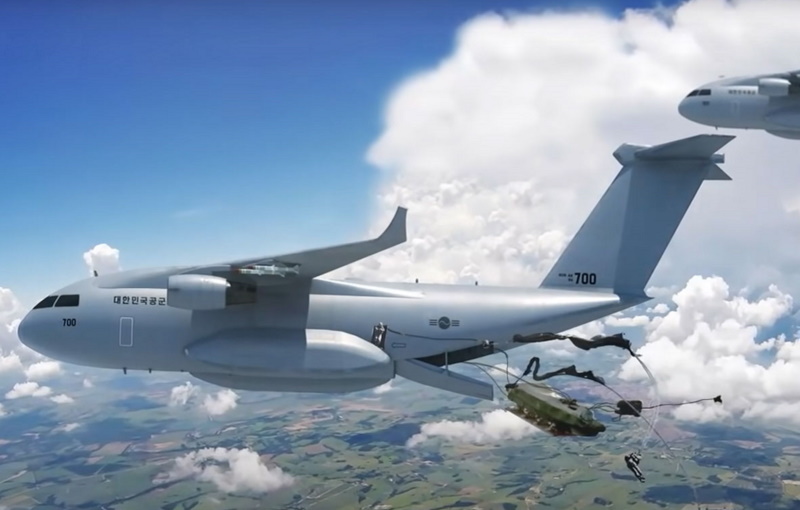
* Sources include:
Most of the data was acquired from various editions of JANE'S ALL THE WORLD'S AIRCRAFT.
* Illustrations credits:
* Revision history:
v1.0.0 / 01 dec 15 v1.0.1 / 01 nov 17 / Update, review, & polish. v1.0.2 / 01 oct 19 / Update, review, & polish. v1.1.0 / 01 aug 21 / Added RC-2, KAI multirole cargolifter. v1.1.1 / 01 jul 23 / Review & polish. v1.1.2 / 01 jul 25 / Review & polish.BACK_TO_TOP
